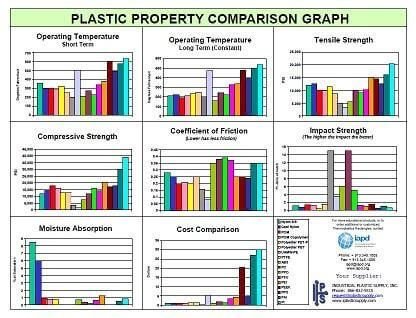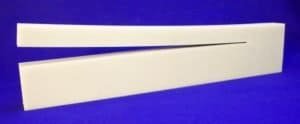
Best Methods To Pick The Proper Plastic Sheet Materials
Best Tools To Assist In Your Plastic Sheet Search
Use the best available tools to narrow down the best plastic sheet material for your application.
What are the best methods to pick the proper plastic sheet material?
Use the tools that the professionals use to find the best plastic material for your application.
Where To Begin
The process of picking the proper plastic material starts with determining the ‘must have’ physical properties needed for your application. Designing a part with the minimum performance factors in mind will help to eliminate an overly
expensive part.
Critical factors to consider are:
- Temperature requirements (short term and long term)
- Chemical or Environmental Requirements
- UV resistance (Will it be in direct sunlight)
- Color or Transparency
- Strengths (Impact and Compression)
- Compliance Issues (Certification for FDA, NSF, Dairy, etc.)
Review The Plastic Property Comparison Guide
The first tool suggested is a chart produced by the IAPD (International Association of Plastic Distribution – https://iapd.org/) linked in picture below, and listed on this chart are the most common plastic sheet and plastic rod materials that are commonly available. In addition, the chart compares the physical properties of these common plastic materials. Click on picture to access chart.![]()
Included in this chart is a relative cost comparison, which will assist in limiting the materials to proper plastics for a application without over-designing and using an expensive ‘over kill’ material. Some common plastic sheet materials can be very expensive. Materials like PEEK (PolyEtherEtherKetone) can be in the $100 per pound range or more.
Start Search With Temperature Resistance
After looking over the IAPD (International Association of Plastic Distribution) Physical Properties Chart above, now it is time to evaluate specifics for your application. The critical factors listed above are ranked by most important to least important. If your part needs to handle a continuous temperature of 300 degrees F, this is a critical physical property. Picking a material that softens at 250 degrees is a
recipe for disaster. Pick a material that can handle the temperature first.
Will Part Have Chemical Exposure
Next, look at environmental requirements. Parts exposed to chemicals are important to research. Find the chemical make up and the concentration of the chemical to insure the material you pick can handle this solution. Many plastics have excellent chemical resistance as evidenced by evaluating the container the chemicals are stored in already. A common plastic that is chemical resistant is Polypropylene, the same material used for automotive batteries. While Polypropylene and HDPE sheets are excellent in chemical resistance, their temperature range is quite limited. Also, these two plastics can not be easily bonded or glued, and would require heat welding for assembly.
Does Your Part Live In The Sun
Most plastics do not handle long exposure to direct sunlight without an additional UV additive. The one exception is Acrylic, which is the most UV resistant plastic sheet available. Some plastics handle UV well if they have a carbon black additive, or a extra UV package added at time of production.
How Critical Is The Color
The most common colors in many plastic sheets are Natural (white to tan) and Black. While other colors are available with a special run, this may require a large minimum order. Some plastics, like HDPE are available in many colors and textures for use in marine, playground and food processing applications. In many plastic applications, a machined part is being made, and the color is the least important factor. If it is an internal part of a machine, no one really cares about the color of the part. Some clients look for materials in a specific color to help ‘brand’ their parts for easy replacement and identification.

Nylon with huge amount of stress, cooled too quickly.
How Much Stress Will The Part See
Strength is a wide range of physical properties covering many stresses a part may be exposed to. From impact to compression, expansion to tensile strength, all of these can be critical in designing a plastic part. There are other factors in the ‘Strength’ realm, like Notched Izod and water absorption. If your part will be exposed to crushing pressure, pulling apart force or impact, these are critical things to consider prior to picking your plastic part.
PTFE is a soft and slippery plastic, but will ‘cold flow’ under high pressure, and High Pressure Laminates like G-10 FR 4 sheet can withstand some of the highest pressures. The Notched Izod tests for materials that break easily if a scored mark has been made in the surface. Acrylics break very easily if scored, but UHMW will not break at all under the same test.
What Agency Approval May Be Required
In many applications a part may require approval or testing to meet a third party certification. One such common application is for materials in food processing applications. Common requests included UL ratings, Fire Ratings, Military specifications and many more. Food contact is a popular request, covering material that is either FDA (Food and Drug Administration) or NSF (National Sanitation Foundation) approved. These agencies insure that materials are rigorously tested and comply with their requirements for safety. Some common materials used in food processing that meet the FDA certification are Acetal Copolymer – Acetal Homopolymer, HDPE, UHMW and Nylon, plus many others.
Once these steps have been completed, several materials should present themselves as meeting your criteria and physical property requirement. Unfortunately there is no one perfect plastic that works in all applications. However, for almost every application, there is a material that will work, and work better than most other substrates.
Cool Online Tool
There is also an additional tool that can be used to help identify some of these properties quickly, the Gehr Plastic Selector online application.
If you are still in need of assistance in identifying an appropriate plastic material, contact an experienced Plasticologist at Industrial Plastic Supply, Inc. – call 866-832-9315
Also see the article, New Methods To Pick Proper Plastic Sheet Materials, for additional information on this subject.